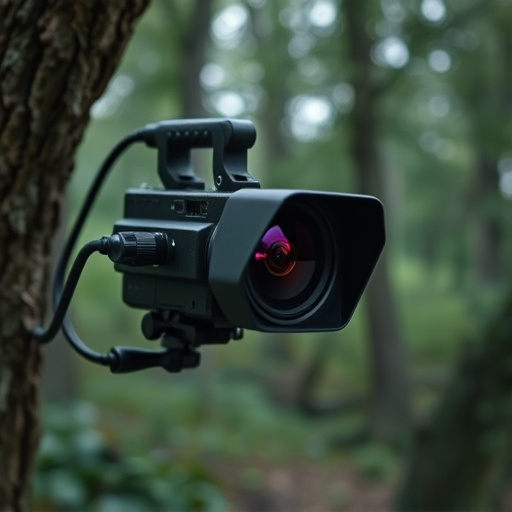Tiny cameras for home monitoring have grown prevalent, raising privacy concerns. Advanced lens detection technology using computer vision identifies hidden cameras in real-time by analyzing visual patterns and anomalies. Smartphone apps empower users to proactively ensure their privacy through image and video analysis. Balancing security and privacy requires informed camera placement, transparency, and knowledge of local surveillance regulations.
Uncover the hidden world of spy camera lens detection using your smartphone. With advancements in technology, tiny cameras have found their way into everyday objects, raising concerns about privacy. This article explores how you can identify these concealed lenses and stay vigilant. Learn about spy camera lens detection technology, discover methods to spot them in various devices, and understand the implications for home monitoring while prioritizing privacy and security.
- Understanding Spy Camera Lens Detection Technology
- Identifying Tiny Cameras in Everyday Objects
- Using Your Phone to Spot Hidden Lenses
- Home Monitoring: Privacy and Security Considerations
Understanding Spy Camera Lens Detection Technology
Spy camera lens detection technology has evolved significantly, especially with the increasing prevalence of tiny cameras for home monitoring. This technology leverages advanced computer vision and image processing algorithms to identify and locate hidden camera lenses in real-time. By analyzing visual patterns and anomalies, these systems can detect even the smallest or discreetly placed lenses, ensuring users are aware of potential surveillance.
The process typically involves a phone’s camera capturing an image or video feed, which is then processed by specialized software. This software detects unusual light reflections, distortions, or other visual cues indicative of a spy camera lens. Once detected, users are alerted, allowing them to take appropriate actions, such as disabling the hidden camera or taking steps to enhance their privacy. This technology is particularly useful for individuals concerned about covert surveillance in their homes or workplaces.
Identifying Tiny Cameras in Everyday Objects
In today’s digital age, tiny cameras have found their way into everyday objects, making them near-impossible to spot with the naked eye. These miniature devices, often disguised as common household items or accessories, pose a significant concern for privacy and home monitoring. What was once a niche worry for tech-savvy individuals has become a broader issue with the proliferation of these hidden cameras.
Whether it’s a seemingly innocuous decorative item or a smart device meant for home security, these tiny cameras can capture sensitive information without users’ knowledge. This raises important questions about privacy rights and the ethical use of technology. For those seeking to safeguard their personal spaces, being aware of such concealed devices is crucial. With the right tools and knowledge, it’s possible to detect these hidden cameras, ensuring a greater sense of security in one’s home environment, especially when it comes to protecting sensitive areas like bedrooms or offices from prying eyes.
Using Your Phone to Spot Hidden Lenses
With the rise of tiny cameras for home monitoring, it’s becoming increasingly important to know how to spot them. Your smartphone can be a powerful tool in this detection process. Through specific apps designed for lens detection, you can analyze images and videos for any signs of hidden lenses. These apps use advanced algorithms to scan through photos, looking for patterns and anomalies that might indicate the presence of a spy camera.
By simply taking a picture or recording a video and then running it through these apps, you can gain insights into potential security threats. Many factors can help identify hidden lenses, such as unusual reflections, tiny dots or lines in the corner of your frame, or even faint digital artifacts. With a bit of vigilance and the right tools at hand—in this case, your phone—you can ensure that your privacy is protected from these hidden cameras for home monitoring.
Home Monitoring: Privacy and Security Considerations
Home Monitoring using tiny cameras has become a prevalent concern in the digital age, where privacy and security are paramount. As these miniature devices offer discreet surveillance capabilities, they can be used for legitimate home monitoring purposes such as ensuring family safety, preventing property damage, or aiding in elderly care. However, their invisible nature also raises valid ethical questions. Homeowners must consider the potential invasion of privacy both internally and externally, especially when placement is not clearly evident.
The use of spy cameras for home monitoring requires a delicate balance between personal security and the right to privacy. It’s crucial that users implement strict guidelines on where and how these tiny cameras are installed, ensuring transparency in their operation. Additionally, staying informed about local laws and regulations related to surveillance technology is essential to avoid any legal complications.
Spy camera lens detection using your phone has become a valuable tool for identifying hidden surveillance devices in everyday objects. By leveraging advanced technology, individuals can now stay vigilant against potential privacy breaches, especially in the context of tiny cameras for home monitoring. While it’s essential to respect privacy rights, being aware of these concealed lenses empowers users to take proactive measures to secure their personal spaces. As we navigate a world where technology advances rapidly, staying informed about such tools is crucial for maintaining a safe and private living environment.
